Globally, mangrove forests have been exploited, degraded and destroyed mainly by human activity like cutting for timber, fuel and charcoal, for land development near the ocean and urbanisation, pollution and, more recently, climate change impacts. In the past decade, there has been growing concern over the high loss of mangrove ecosystems leading to various interventions such as restoration to curb the destruction.
The situation is not any different in Kenya’s Lamu County. A renowned archipelago founded in the 12th Century and located 240 kilometres from Mombasa, Lamu is more famous for its rich Swahili culture and unique attractions – the historical Old Town and the fusion of Swahili, Arabic, Persian, Indian and European architecture; and a thriving economy built on slave trade. Much less known is its historical position as a flourishing entrepôt on the east coast of Africa for elephant ivory, rhino horn, turtle shells, shark fins, spices, ambergis and mangrove poles that were shipped through the Indian Ocean to the Middle East and India.
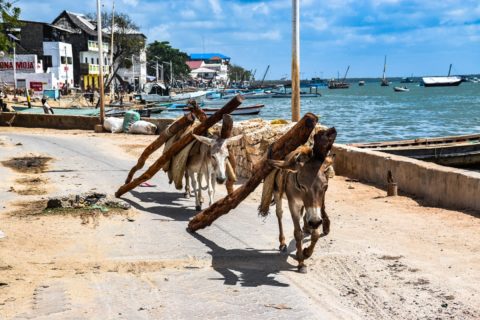
Donkeys hauling mangrove poles in Lamu Town
Mangroves and the Lamu community, as with other East Africa’s coastal societies, are closely intertwined. Together with the neighbouring Tana River County, Lamu harbours approximately 61% of the country’s mangrove forests according to the National Mangrove Ecosystem Plan by the Kenya Forest Service (KFS). The communities harvest these gnarly-rooted trees for poles and timber for house construction, fuel for cooking and charcoal, for traditional lime production, traditional medicine and therapy, and beekeeping for honey, amongst other benefits. Besides this, the fishing community largely depends on mangroves as breeding grounds and nurseries. Owing to a growing human population and rising attendant needs, the pressure on mangrove forests has been immense.
“In Lamu, we harvest mangroves legally. I have been in this business since 1992. The cutters are in the business as it’s their main source of livelihood. If there is an alternative and sustainable livelihood, then we would encourage them to shift from mangrove cutting to stem mangrove loss,” explains Abdulrahman Lali, Chairman of Lamu Community Forest Association (CFA).
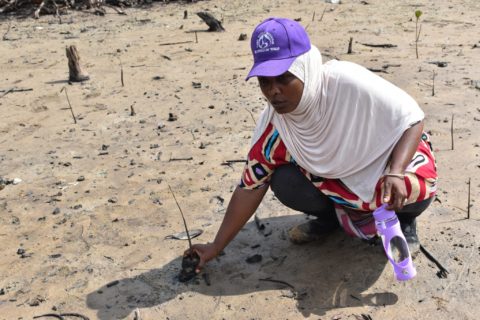
Loi Bwanaali of Kililana uproots a seedling planted in a plastic pocket at Kitangani in Mokowe, Lamu
In an endeavour to restore mangroves, active planting has gained currency worldwide including in Lamu and Tana River counties. However, these restoration efforts have been failing to a large extent. Re-establishing the conditions that support mangrove ecosystems is a difficult and, understandably, slow undertaking. Unlike conventional terrestrial forests, planting mangroves in an area that has been altered to a large extent does not mean that they will grow and thrive.
Restoration, however, is possible. But it needs to be done right and may require significant investment particularly if the area has changed considerably. The investment begins with working in close partnership with the local communities, authorities, civil society and research institutions including training on sound techniques such as the Community-Based Ecological Mangrove Restoration (CBEMR) advocated by Mangrove Action Project (MAP) and successfully implemented in numerous countries in the world.
“Mangroves need lots of salt”
Last March, MAP joined hands with Wetlands International to train 21 representatives from community organisations, government and county officials, research institutions and civil society drawn from Lamu, Tana River and Mombasa counties. Women had a 50 per cent representation as they are mainly involved in actual restoration efforts. Interactions during the training were interesting, and sometimes discussions evolved into intense and heated debates.
Some, if not most, trainees had to format and reformat what they knew as facts about mangroves and their restoration. Mwanahamisi Jillo, a manager with Lower Tana Delta Conservation Trust, travelled some 120 kilometres east with her 11-month baby to attend the training in Lamu. “We have been trying to restore mangroves in our area and I have attended several training workshops on restoration. But it’s at this CBEMR training that I heard for the first time that too much salt is bad for mangroves. And I know none of my colleagues is aware of that fact!”
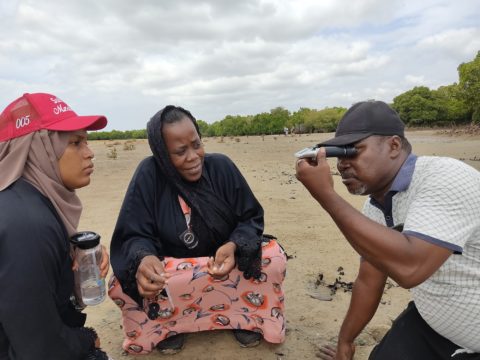
Abdulrahman Lali checking salinity levels as Mwanahamisi Jillo (C) and Rukia Bwanamaka look on
This view is shared by Lali. “I am almost 50 years old and in my whole life, I have all along known that salt is a necessity for healthy mangroves. At the beginning of CBEMR training, I argued with Dominic about mangroves being salt-tolerant. But after the field visits with the MAP team to assess the hydrology, measure salinity and pH levels, I have observed and agreed that too much salt is a stressor to our unique forests.”

Dr Dominic Wodehouse and Dr Emmanuel Japhet (L) showing participants how to measure salinity and pH
Dr Dominic Wodehouse, MAP’s CEO and lead trainer explains that the CBEMR approach recognises the critical role that local communities have in restoration as it offers a sense of empowerment and involvement in resolving their own environmental, social and economic issues of development. Prior to the actual training, the MAP team engages in extensive discussions with local authorities and communities to ensure the workshop is tailored to the participants’ needs and the local mangrove conditions. The training involves interactive class sessions, table exercises, group sessions and numerous field visits, all translated into the common local language, to ensure comprehension.
Supporting nature in restoration
Restoring mangroves is beyond conventional forestry. Besides developing nurseries and supplying seedlings, there is a lot more that must be considered in mangrove restoration. Swabra Mohammed is the secretary of Matondoni Tarazak Women Group. Her group established a nursery in 2021 and they have sold seedlings for restoration to two stakeholders. “This training has been an eye-opener. Over and above species zonation and assessing hydrology, we have gained knowledge on how to identify mature propagules of various species and that the water we use in the nursery should be balanced – not too saline, acidic or alkaline.”
CBEMR has five critical steps for ecological restoration of mangroves, but this comes second. “We first apply the knowledge we have to protect the existing mangroves. Where the need arises, successful and cost-effective restoration comes second,” says Wodehouse.
The technique aids the biophysical and socioeconomic conditions in place and then allows nature to do the rest. This helps to optimise species to site matching leading to better survival, faster growth, and a more diverse and resilient mangrove forest.
As the training progressed, Lali would voluntarily sometimes take the role of timekeeper during refreshment breaks, to the amazement of his fellow participants. “I have been to Mombasa, Malindi and Nairobi for mangrove restoration training workshops organised by various institutions. But this CBEMR training is like none other. In my case, I wished it had been conducted away from Lamu so that I could fully focus on it without interruptions from my line of work.”
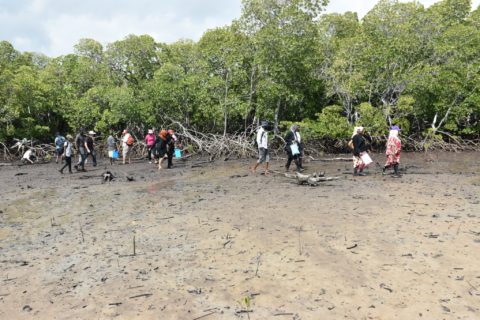
Kitangani site
On the second last field visit at Kitangani in Mokowe, as the trainees make their way through the site, they point out some of the issues, some glaring, that have contributed to the low restoration success rate – some seedlings planted with the plastic pockets, planting in a channel, poor drainage and inundated areas, high salinity, and wrong or single-species planting, amongst others. Here, mangrove seedlings have been planted four times, the latest one earlier this year.
“The CBEMR training is holistic and practical as it has enabled us to identify the challenges and opportunities in mangrove ecosystem restoration. For example, what we have inadvertently done wrong in the past, and what needs to be done going forward at the community, county and national levels,” states Julius Nandwa, KFS’s Lamu Forester.
Lali explains that mangrove restoration rates have been low in Lamu owing to limited knowledge and that there is a need to have more community members trained in successful techniques such as the CBEMR.
Appreciating the knowledge gained from the training, Jillo also laments about the restoration efforts she and her colleagues have done in the past. “I wish this CBEMR training had been conducted years ago. Had I known how to identify the ecological and biophysical conditions first, I would never have planted mangroves in drainages and waterways as I have done. It’s the best training I have participated in and I am grateful to Wetlands International and MAP for this opportunity. I will ensure that I put into practice what I have learnt and share the knowledge with my colleagues.”
“Together with the chairlady, we plan to meet with our group members and even other community members who are involved in mangrove restoration and plan how to share the knowledge gained on the CBEMR technique,” states Swabra.
Wetlands International has planned follow-up sessions with the community members on mangrove restoration efforts in both counties.

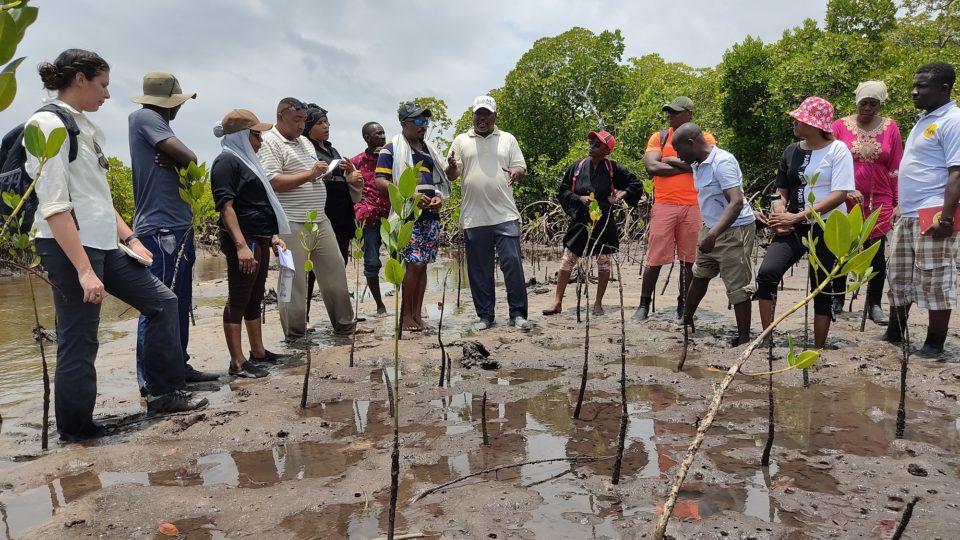
Leave a comment